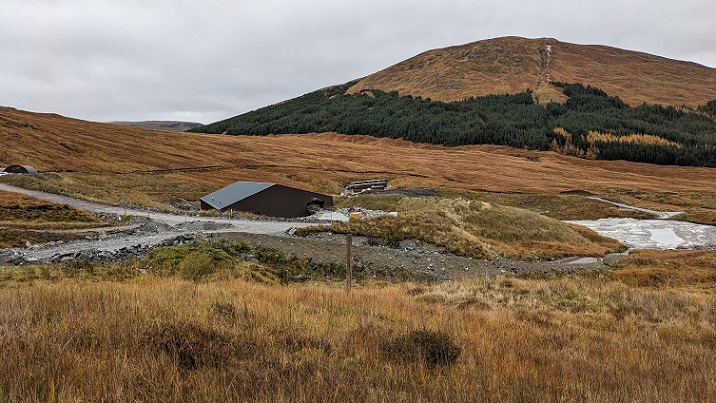
Shortly after I wrote to Dr Heather Reid, the Convener of the Loch Lomond and Trossachs National Park Authority (LLTNPA), questioning her decision that dealing with the potential risks at the Cononish goldmine caused by Scotgold’s financial difficulties was purely an operational matter (see here), a report on the mine appeared among the papers for the Planning and Access Committee meeting for 30th October. It appears what has been happening at Cononish is a matter for the board after all! Predictably, no-one from the LLTNPA had the courtesy to inform me of this U-turn.
Having discovered the report by accident, I wrote again to Dr Reid Email 23rd October 2023 highlighting a number of serious deficiencies in it and asking that my concerns be passed on to Board Members. This post builds on the critique I offered in that email and combines it with evidence of what is happening on the ground from a visit I made to the gold-mine on Wednesday..
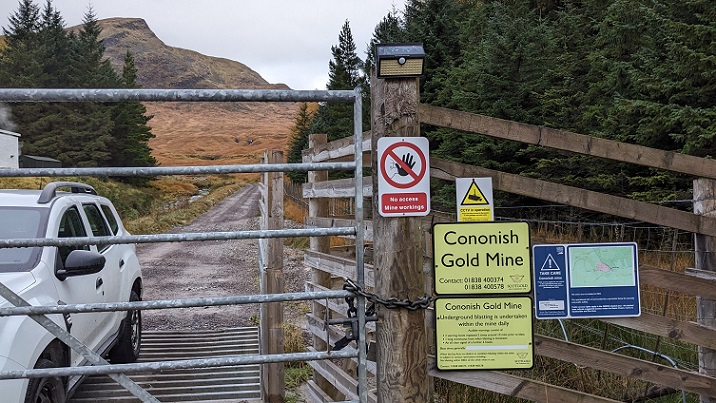
The Committee Report describes itself as the “Annual Report” to board members on the gold mine. It is in the same format and many of its paragraphs identical to the annual report which was considered last December (see here) but it has been brought forward two months for reasons that are not explained. It appears that under pressure to say something about the mine, it was quicker for senior management to ask staff to cut and paste content from the previous report than explain what has really been going on this year and to consider the risks.
The Committee Report’s handling of the financial crisis at the goldmine
The first and only mention of the financial crisis at the mine is at the end of the report, on page 10:

The first sentence misleadingly suggests the crisis at the goldmine was relatively recent. In fact, it was obvious from the Spring, as I explained back at the start of April (see here): Scotgold’s balance sheet had been deteriorating seriously for two years, it had been forced to issue new shares in February before in March it announced a £5.2m loss in the six months to December 2022. Had the LLTNPA been monitoring mine extraction properly they should also have been aware that from January gold production had plummeted. That could only mean Scotgold’s financial position was going to deteriorate still further so hard did the LLTNPA respond in those six months?
One shouldn’t need a Masters in Business Administration to realise that when a business is in financial trouble it will try to reduce its costs, both by introducing efficiencies – hence Scotgold announcing a change to long stope mining early this year – and by cutting the things that are least essential to keeping an operation going, such as protection of the natural environment. Paragraphs 5.2 and 5.3 of the report demonstrate that either LLTNPA senior management have no appreciation of the additional risks caused by Scotgold’s near financial collapse or they are deliberately trying to conceal those risks from Board Members.
No detail is provided about the “core staff team” that has been kept on site, what the “care and maintenance programme covers” or what information the weekly updates to LLTNPA include. This makes it impossible for LLTNPA Board Members to scrutinise whether staff are right to be “content” with the arrangements.
Having seen the mine and spoken to people still working on the site on our visit, the focus of the “care and maintenance programme” seems to be mainly about ensuring the mine remains in working order, in case a new investor is found – we were told it was ready to start operations immediately – than the environment around it.
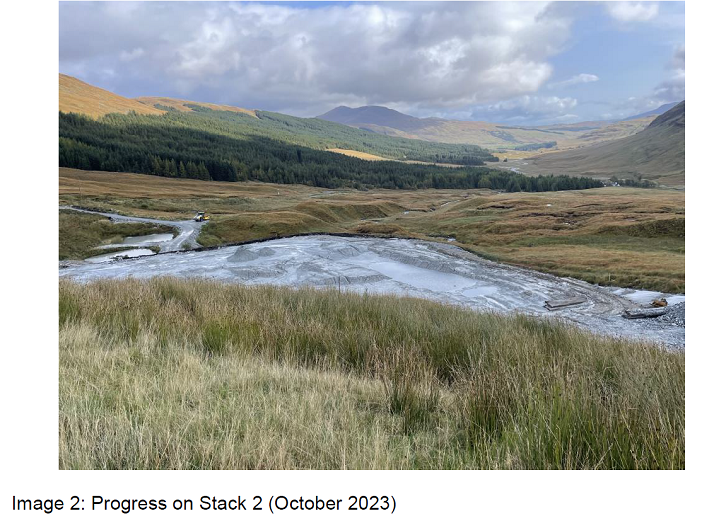
Besides clarifying whether the “additional unannounced site visit on 3rd October” has been the only “additional” visit since the crisis became public at the start of the year, LLTNPA Board members could also ask whether any work has been undertaken on the tailings stacks since 3rd October to make them safer? Judging by my photos, the answer appears no.
As for the claim in 5.3 that the LLTNPA’s priority is ensuring compliance with planning conditions and the Section 75 Agreement, that would be a welcome change but the report contains no evidence that that is happening, rather the opposite.
The Restoration bonds have not been uprated as promised
In the December 2022 Annual Report staff reported that the two restoration bonds for the mine were insufficient and “The review of both bond amounts is anticipated to be concluded in January 2023”. In fact the review of the largest restoration bond, for the mine area, was concluded around 31st March (see here). The Committee report shows Scotgold took three months to pay anything and six months later has paid less than half the increase:
“A payment of £40,000 was received by the National Park Authority in June 2023 and the remaining £45,848.24 remains outstanding despite reminders that this payment is overdue.”
That is a clear breach of the Section 75 Agreement, the legal agreement governing the operation of the mine, and should have the alarm bells ringing. Instead of using this to invite board discussion about the crisis and how the LLTNPA might use its planning powers in response, the paragraph concludes “it is considered that the current funds are sufficient relative to the current phase of stack preparation and restoration”. In other words, because the mine is so behind schedule, LLTNPA senior staff believe there is less to restore. That remains to be seen – if the amount is not sufficient will the Chief Executive Gordon Watson and Director of Place, Stuart Mearns, commit to paying for any shortfall out of their salaries? Meantime LLTNPA senior staff have given Scotgold another clear message that they are not prepared to enforce planning conditions (see below).
As for the Greater Cononish Glen Management Plan (GCGMP) bond, “Initial discussions have been held with Scotgold and Ironside Farrar”. Negotiations which the last Annual Report stated would be completed in January have barely started. One can understand why that would suit Scotgold, given their financial position, but what explains the complacency of LLTNPA senior management?
The LLTNPA’s failure to enforce planning conditions
My last post on the gold mine (see here) explained how actions agreed in the mine monitoring reports, which are kept secret for six months, have not been addressed from one report to the next, nor are most being marked “red” as required. This is contrary to the LLTNPA’s policy and a fundamental failure in governance which senior staff appear to be trying to keep from Board Members.
While the Committee Report includes a vague reference to outstanding actions by Scotgold, it makes no attempt to analyse the risks caused by these failures to comply with planning conditions.
That last post also showed how the last publicly available monitoring report from March, published belatedly at the end of September, showed a number of pollution incidents had taken place earlier this year. There is no mention of that in the Committee Report nor of what pollution incidents have been recorded since. This is despite the fact that in May evidence appeared on social media showing the state of the mine and how polluted mine water was being released into the River Cononish (see here).
All of this provides good evidence to suggest that the risks to the natural environment in Cononish Glen have been increasing as a result of Scotgold running out of money. So why are LLTNPA senior management so keen to conceal these facts from the public and their board?
The tailings stacks
Under the original planning conditions agreed for the tailings stacks, the shear key had to be constructed before any tailings could be deposited. Previously LLTNPA staff had helpfully described the shear key as “in effect the retaining wall element of the stack structure”. However, last year LLTNPA staff agreed that Scotgold could start depositing tailings at Stack 2, which they started to do around February, BEFORE the shear key was complete. There is no mention of this or the potential risks created by the lack of a “retaining wall” around part of the stack in the Committee report. Perhaps the shear key is now complete? If so, that is another secret to be kept from the public.

The photos of Stack 2 suggest that relatively few tailings have been deposited there in the last six months, an indication that the gold mining was not going according to plan:
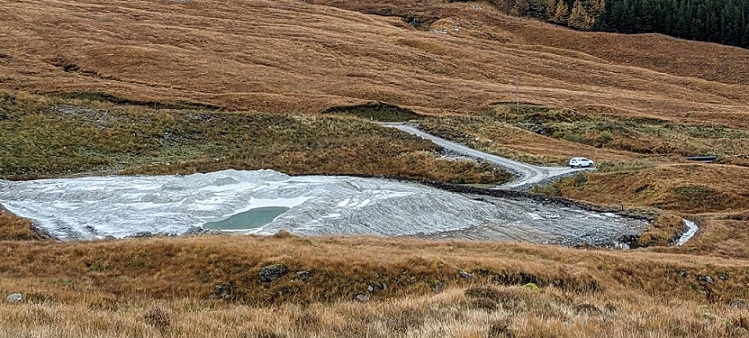
Had there been more tailings, the risk of an environmental disaster when the workforce was laid off would almost certainly have been greater than it is now. Should anyone be confident, however, about what an extreme rain event might do to Stack 2 as it appeared on Wednesday
That wet tailings are a serious problem is shown by the planning application Scotgold submitted in February. This (see here) was to erect a metal roof over the tailings being stored on the north side of the mine shed:
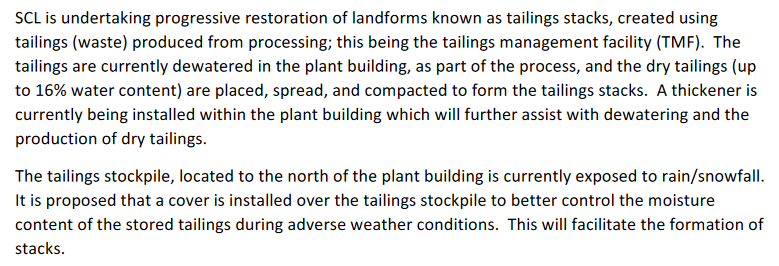
Perhaps staff felt there was no point as they knew Scotgold had insufficient funds to build such a shelter? If so, that was surely even more of a reason to inform Board Members of all the risks posed by the half-finished sodden tailings stacks possibly still missing part of their shear key.
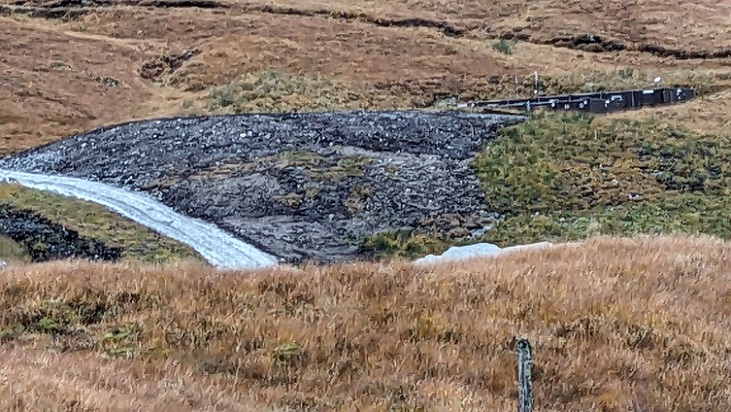
“There remains a small area of stack 1 which requires to be restored. This will be completed when more turf becomes available from stack 2.”
Looking at the photos of Stack 2 it is very hard to see where all the turf to restore this “small” area of bare peat is going to come from. Whatever the answer, the longer the peat remains exposed to air, the more it oxidises and the more carbon dioxides is leaked out into the atmosphere. No concern is expressed about this in the Committee Report which, however, waxes lyrical over four paragraphs about the “Habitat Enhancement Areas” between the stacks where peatbog is apparently being restored. These appear smaller than the area of exposed peat!
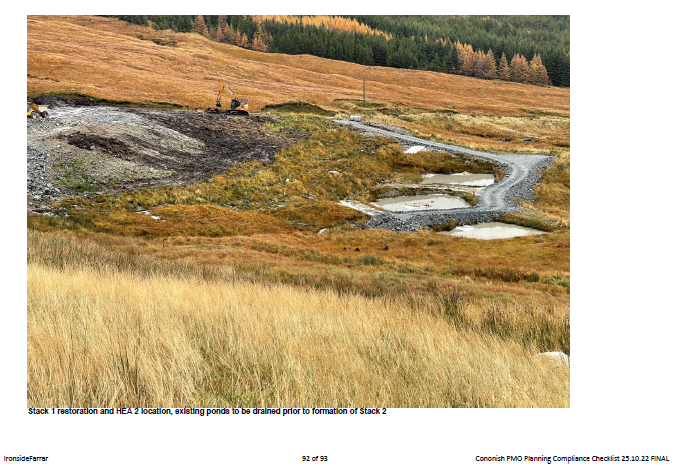
A year ago, in October 2022, the three ponds in the photo were due to be drained BEFORE work on Stack 2 started. Image 2 from the Committee Report, featured above, shows that two are still there. Neither it nor the monitoring reports provide any explanation for this change of plan. Could this be because the stack was constructed when the tailings were too wet, lots of water has been slowly draining out ever since and the lagoons are still needed to collect that? If so, what does that say about the stability of the stack and the pollution risks on site?
Revised Waste Management Plan
The answers to these questions about the tailings stacks should in theory be provided by the 5 year review of the Waste Management Plan which is due to be submitted to the LLTNPA before the end of October. There is no reference to this in the Committee Report despite the fact that it is the management of mine waste that poses the greatest environmental risks. It is therefore a key document and if not supplied by Tuesday that should ring more than alarm bells, it should prompt enforcement action.
Mine traffic and recreational amenity in Cononish Glen
One of the other undecided new planning applications referred to in the Committee Report is:
“2023/0076/DET (see here) Retention of containers for accommodating site office, welfare facilities and laboratory (including associated infrastructure) and formation of associated parking areas.”
This application, if approved, would create 12 new official parking spaces at the mine. The Committee Report fails to mention that this would undermine one of the original conditions attached to the mine, namely that cars should be left in an extension to the walkers car park at Dal Righ and staff should be transported to the mine by a shuttle bus.
Scotgold in their supporting statement to the application quite rightly stated the office accommodation on the site was “designed so not to cause visual clutter and adverse amenity effects for recreational visitors to the glen” but failed to say those conditions about amenity applied to traffic. Gold mine staff have now been driving their vehicles up to the mine for months and the LLTNPA has failed to take any enforcement action, effectively pre-judging the planning application. Again there is no mention of this in the committee report.
The proposal to create new car parking appears to be another example of Scotgold cutting back on their “green” commitments due to their financial circumstances: get staff to pay for their own transport up to the mine rather than provide a bus service.
The risks of Scotgold going into adminstration
Lastly, there is no attempt in the Committee Report to consider the risks or what should happen if SGZ Cononish, Scotgold’s subsidiary which operates the mine, goes into administration. On 16th October Scotgold announced it was in “advanced discussions” with a new strategic investor. The staff we spoke to at the mine on Wednesday were waiting to be told about their jobs last week but there has been no more news since then. It is now over 28 days since most of the staff were put on unpaid leave and under UK employment law they can now apply for redundancy and Scotgold has to reply within 7 days (see here). The crisis is therefore likely to come to a head in the next week.
The Section 75 agreement is not entirely clear or prescriptive about what happens if the operator goes into administration and allows a number of options. There are provisions in the Section 75 for the LLTNPA to close the mine temporarily while a new restoration bond is being negotiated but also to activate the restoration bond if a decision is taken to close the mine or it is abandoned for a year.
In my view decisions about these options should not be treated as an operational matter left to staff but should be taken by the Board Members. The Committee Report, however, doesn’t even include a recommendation that the Planning Committee or full board should meet again if Scotgold goes bust.
The LLTNPA Planning Committee Meeting on Monday is going to look pretty stupid if they note the “Annual Report” on the gold mine, as officers recommend, and then SGZ Cononish goes into administration on Tuesday without them having discussed what happens next.
A National Park Authority on the brink
I have not had a reply from Dr Reid to my email of 23rd October (link at top) drawing attention to the flaws in the Committee Report and asking Board Members to be made aware of this before the meeting on Monday. Today I will send her and the Convener of the Planning Committee, Claire Chapman, a link to this post and ask for the LLTNPA to discuss the issues I have raised.
I doubt they will do so in any meaningful way. As documented on this blog, the failings of the LLTNPA Board go back a long way and they have basically now ceded all power to their Chief Executive, Gordon Watson. I don’t even know whether my last email was read by Dr Reid. It is almost impossible to contact Dr Reid or any Board Member appointed by the Scottish Government without going through staff first. This system enables senior staff to ensure that Board Members only hear what staff want them to hear, as they have done with the “Annual Report” on the Cononish goldmine.
The members of the LLTNPA’s Planning Committee have an opportunity to rectify that in respect of management of risks at the Cononish goldmine on Monday. If they fail to do so, I believe Lorna Slater as Scottish Minister responsible should intervene.
The need to reform the LLTNPA and rectify what has gone wrong before creating any new National Parks in Scotland should be obvious. And before concluding that her proposal (see here) to increase the proportion of board appointments within Ministerial gift is the answer, Lorna Slater should consider that Dr Reid, Claire Chapman and Ronnie Erskine, the chair of the Risk and Audit Committee, are ALL appointed by the Scottish Government.
Thanks, again, to Nick Kempe for keeping this matter in the public eye. It is a visible example of the questionable competence of management of the LLTNPA.
For all that the annual report contains and that it fails to report on, it concludes as follows: “It is recommended that Members NOTE the contents of this report and the annual update that has been provided on the development.” Translated, that means, “please sit on your hands and ask no questions”.
An inadequate and misleading recommendation, submitted in the name of Stuart Mearns, who has been central to approving the original application and the subsequent monitoring of compliance with conditions. For all matters relating to Cononish, Mr Mearns needs to be replaced by someone unrelated to past decisions, if Heather Reid and the LLTNPA Board members are to have any credibility.
The park is not fit for purpose, not just the board
I think we have more than sufficient evidence to show the national park model in Scotland is failing completely, whether it is a gold mine or a railway or access roads or tree planting it seems developers can do as they please without ever being held to account by the park authorities. The only solution is stop pretending these park boards do anything useful and stop them now and go back to drawing board, otherwise there will be nothing left in the parks worth bothering about. I look at national park in other countries, particularly Canada and see what could be achieved if board actually operated in the interests of protecting the park environment and I just despair at the pathetic attempts made in Scotland.
Your ordinary planning officer is simply not technically competant in these matters. The park urgently needs to employ qualified mining consultants to monitor and advise. If they dont- then they simply need to look at East Ayrshire where the Head of Planning carried the can for the coal mining debacle. Its happening again.
The board is only ultimately answerable to (and are supposed to take guidance from) is the Scottish Government – ‘The Park’ being an NDPB and 100% funded by taxpayers money – it is perhaps the Government we should be seeking answers from via FOI and other means, which may or may not force the board to take some action to ensure the protection of this area (and others).
As far as I know the board meets a handful of times a year and pick up a healthy “expenses” remuneration, I can’t remember what this is but runs into thousands – be interesting to see what that worked out an hour! or how much the board costs ‘us’ a year.
The alarm bells with the board started many years ago with a few individuals buying shares in Scotgold then voting whether planning permission should be granted – yes – they subsequently resigned but that was how much those board members were dedicated to ‘The Park’.
The only thing the board needs to consider and see if it aligns to is the below – if it doesn’t and they are not prepared to take action then the Gov need to act.
The National Parks (Scotland) Act 2000 sets out four aims:
• To conserve and enhance the natural and cultural heritage of the area
• To promote the sustainable use of the natural resources of the area
• To promote understanding and enjoyment (including enjoyment in the form of recreation) of the
special qualities of the area by the public
• To promote sustainable social and economic development of the communities of the area.
I note that the Australian owners of SGZ Cononish and SGZ Grampian (previously Scotgold Resources) are in administration.SGZ Grampian held 13 exploration licences under a 5 year term which has ended.
I note a new company, Cononish Mining Limited was registered on 27/11/2023. Directors are the Kansagras, who have mining interests overseas and a dubious safety and environmental record.
Thank you, I will write another post in next week or so and will incorporate that info there, it deserves to be much more widely known
Is anyone still working at cononish gold mine, or is mining finished.
I echo the question posed by Robert Buchanan.
Is the mine still operating?
If so, are the new operators operating the business in a safe manner?
I lived local to the Tyndrum mine and invested in the goldmine many years ago (all monies now sadly gone!).
What is truly irritating is the complete lack of communication from the ‘’owners’ of the mine, no updates on why it failed, no update on the status of the workings and the tailings dump, no interest in saying the surrounding area will not suffer or assurances of the river water quality.
It’s sad and annoying to witness such poor business practices by a company that was trusted by people who lived locally. Just bloody bad manners!
lets hope Alba resources in Wales fairs better..we shall soon see if there mine is commercial but i guess that doesnt mean guaranteed success but it is a proven mine and the latest grades seem brilliant..